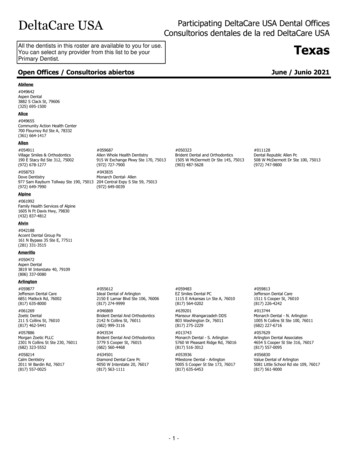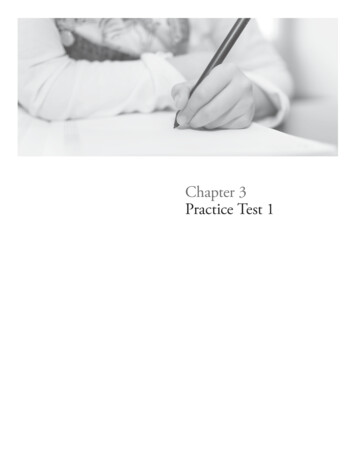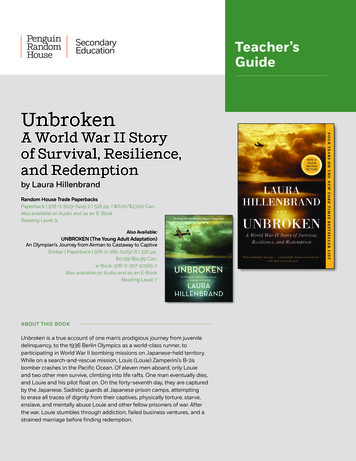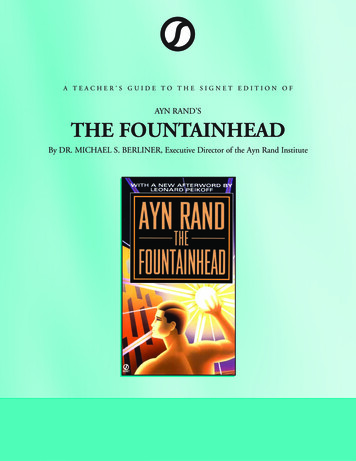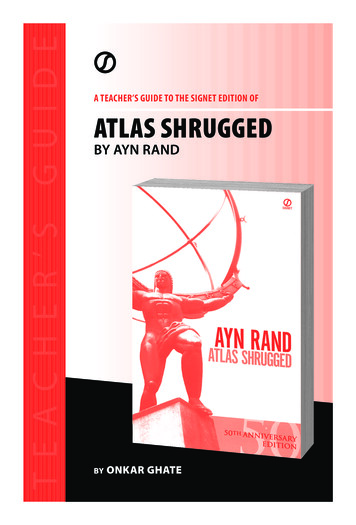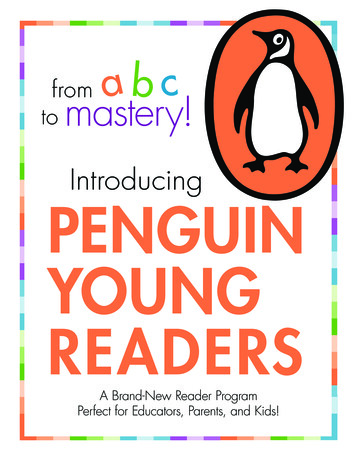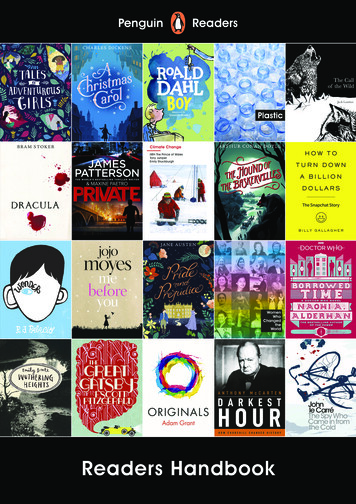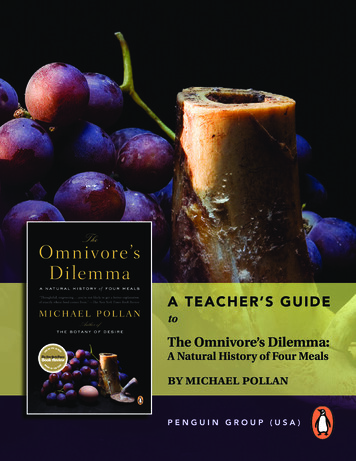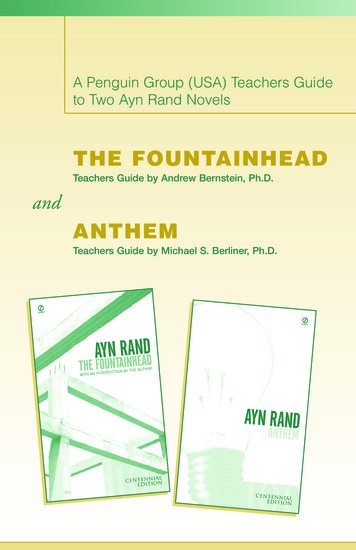
Transcription
A Penguin Group (USA) Teachers Guideto Two Ayn Rand NovelsThe FountainheadTeachers Guide by Andrew Bernstein, Ph.D.andANTHEMTeachers Guide by Michael S. Berliner, Ph.D.
The Fountainhead ISBN 0-451-19115-3Anthem ISBN 0-451-19113-7For additional teachers guides, catalogs,or descriptive brochures, please write to:Penguin Group (USA)Academic Marketing Department375 Hudson StreetNew York, NY 10014-3657academic@penguin.comTo order, call 1-800-526-0275In Canada, write to:Penguin Books Canada Limitedc/o Canbook Distribution ServicesEducation Department1220 Nicholson RoadNewmarket, Ontario L3V 7V1Printed in the United States of AmericaThis teachers guide is being published in cooperation with:The Ayn Rand InstitutePO Box 57044Irvine, CA 92619-7044Tel: 1-800-365-6522Web: http://www.aynrand.orgE-mail: mail@aynrand.org
The FountainheadAbout This Guide.5Introduction.5Principal Characters.6An Overview.6Howard Roark.7Peter Keating.8Ellsworth Toohey.9Gail Wynand.9Dominique Francon.10The Climax of the Novel.11Philosophical Themes in Roark’s Speech.11Suggested Study Questions.15Extending Learning.16Essay Contests.16About the Author of This Guide.16AnthemAbout This Guide.18Theme.18The Value of Anthem to Young Students.19Summary of the Story.20Utopias and Anti-Utopias.21Philosophical Meaning.21Individualism vs. Collectivism.22Selflessness.22Egoism.23Free Will.23Suggested Study Questions and Activities.24An Objectivist Bibliography.26Ayn Rand’s Novels.26Ayn Rand’s Other Fiction.26Ayn Rand’s Nonfiction.26Works by Leonard Peikoff.28Extending Learning.28Essay Contests.28About the Author of This Guide.29Essay Contests.30Of Special Interest to Teachers.323
A Penguin Group (USA) Teachers Guide to Ayn Rand’sThe FountainheadABOUT THIS GUIDEAyn Rand (1905–1982) was born in Russia and educated under the Communists,experiencing first-hand the horrors of totalitarianism. She escaped from Russiain 1926 and came to America because it represented her individualist philosophy.The Fountainhead, published in 1943, was Ayn Rand’s first great success. It wasa best seller then and continues to sell very well today. It was made into apopular movie in 1949 starring Gary Cooper as Howard Roark and Patricia Nealas Dominique Francon.INTRODUCTIONThe Fountainhead has achieved the status of a modern classic because it dramatically concretizes the theme of independence versus dependence, between5
following one’s own ideas or following those of others. This is of particularimportance to high school students who are eager to assert their independencefrom their parents and need a code of ideas and values to guide them. Thestudent needs to know to what extent he must follow his parents, when it ishis right to assert himself against them, when and if he is being improperlyinfluenced by peer pressure, and that it is his right to resist it. He needs todiscover that social pressures pushing him toward unsatisfactory career andmarriage choices are not irresistible forces defining his life—that he canoppose them successfully and often should. And he needs to discover thatunthinking rebellion against the standards of others—being different just tobe different—is as abject a form of dependence on them as blind allegiance.The Fountainhead appeals strongly to the young—and I have seen this appeal yearafter year, with my own high school students—not only because its theme isindependence but also because it presents “a noble vision of man’s nature andof life’s potential” (from Ayn Rand’s Introduction to the novel). That Ayn Randwas able to integrate these issues into a plot structure that crackles withconflict can be explained only by the school of writing to which she belongs:Romantic Realism. She is a Romantic in that she projects men as they might beand ought to be. Although not many men may be currently living up to theideal of independence, they have the capacity to do so, and a reason why: theirsuccess and happiness depend on it. In this, she fundamentally differs from theNaturalist school of fiction, which is content merely to present men as they are.(For further elaboration, see Ayn Rand’s The Romantic Manifesto.) Ayn Randis a Realist in that her heroes are possible and deal with the crucial real-lifeproblems of today; her heroes are never relegated to historical costume dramas,other worlds, or flights of fantasy.For all the literary and intellectual achievements of The Fountainhead, it isbut an overture to Ayn Rand’s greatest achievement: Atlas Shrugged. For youradvanced students, who appreciate The Fountainhead and who are lookingto go further, there is good news: Atlas Shrugged covers in detail the sophisticated themes that The Fountainhead begins to explore.PRINCIPAL CHARACTERSAn OverviewHoward Roark is the main character in The Fountainhead. He is astruggling young architect in the United States of the 1920s and 1930s. Roarkis an early designer in the modern style. He is an innovative genius, but his designs6
are often rejected by clients who want them to conform to traditional standards.Roark’s refusal to compromise causes him to lose many commissions.While Roark struggles, Peter Keating, his rival, rises to the top of thearchitectural profession. He is a mediocre architect, but gives the publicexactly what it is used to. Borrowing from other architects, including Roark,Keating sells out any standards he has ever held in order to reach his goal ofwinning the approval of other people by any means.Roark’s main antagonist in the novel is Ellsworth Toohey, who isthe architectural critic of influence in New York. Toohey, the arch villain inthe novel, denounces Roark for his genius and his integrity, but Toohey’scampaign to discredit Roark is not seen through by most people.Gail Wynand is Toohey’s employer. He is the talented publisher of the NewYork Banner, who uses his newspaper to pander to the lowest public taste andthereby gain popularity and power. Meeting Roark, whom he admires, he isforced into the most agonizing decision of his life: to continue to curry favorwith the masses or live instead according to his own standards.Dominique Francon is the brilliant, passionate woman who lovesRoark, but who is convinced that Roark’s genius has no chance in a corruptworld. Roark is the catalyst for the resolution of her conflict in the novel.Howard RoarkHoward Roark pursues his vision of architecture with an unswerving dedicationand morality that has made him an inspiration to readers. The action of thenovel centers around the opposition to him from many people, all of whomare variations on the basic theme of the novel—independence versus dependence. There are three major sources of opposition to Roark: (1) from thetradition-dominated elements of society (Peter Keating); (2) from the antipathy of active powerlusters who reject his ideas about life and hate the independence for which he stands; and, (3) from the two figures who love himbut have unresolved conflicts which cause them in different ways to opposeRoark (Wynand and Dominique).At the opening of the novel, Roark is expelled from the prestigious StantonInstitute of Architecture. The scene between Roark and the Dean of theschool establishes the conflict of tradition versus innovation. The Deanviews Roark as a rebel who opposes all the rules of architecture. He claimsthat all rules of design come from the great minds of the past, i.e., from otherpeople. Roark disagrees, stating that “what can be done with one substance7
must never be done with another. No two materials are alike. No two sites onearth are alike. No two buildings have the same purpose . . . . Every form hasits own meaning. Every man creates his meaning and form and goal. Why isit so important—what others have done? Why does it become sacred by themere fact of not being your own? Why is anyone and everyone right—so longas it’s not yourself?” (p. 24) This disagreement is crucial to an understanding ofThe Fountainhead, for the book’s central conflict is between people who arereality-centered and people who are centered instead on other people.A development of this theme is the case of the Manhattan Bank Building. Theboard hires Roark to design the building, then ruins Roark’s plan by adding aClassic motif. As the chairman of the board explains: “In this way, though it’snot traditional architecture of course, it will give the public the impression of whatthey’re accustomed to.” (p. 196) Roark tries to explain “why an honest building,like an honest man, had to be of one piece and one faith; what constituted thelife source, the idea in any existing thing or creature, and why—if one smallestpart committed treason to that idea—the thing or the creature was dead; andwhy the good, the high and the noble on earth was only that which kept itsintegrity.” (p. 197) The chairman replies, “There’s no answer to what you’resaying. But unfortunately, in practical life, one can’t always be so flawlesslyconsistent.” (p. 197) Morality to Roark is practical. To the chairman, practicalityrequires one to compromise one’s standards to be popular with others. Roarkrefuses to change his design, on moral grounds, and loses the job. It is thispoint that eloquently explains the personality of Peter Keating.Peter KeatingKeating rises in his profession by two means: deception and manipulation.Keating is quite willing to be “practical” in order to get commissions. Heaspires to be successful as an architect—but the crucial point is that he doesnot aspire to do good work in architecture. Keating is a mediocrity, but thatdoesn’t matter to him, because he is able to convince the public that he is great.How people perceive him is Keating’s fundamental concern. For instance, hebecomes an architect not because he loves to build, but because it will gainhim “social respectability.” He works for Guy Francon, who teaches him howto impress clients by matching ties with socks and wines with foods. He givesup Catherine Halsey (whom he loves) for Dominique Francon (whom hefears) because Dominique’s beauty and connections will impress people.He is an example of a man who never develops values. He is what Ayn Randcalls a “second-hander”: he surrenders his capacity for judgment to other8
people, and therefore, he focuses not on what he thinks, but on what othersthink. He designs by copying the masters of the past. Further, he gets Roarkto help him whenever he needs it, takes all credit for the designs himself, andthen repays Roark by publicly denouncing him. Keating is dependent, as aparasite is, on Roark, on the masters of the past, on the gullibility of the public.Keating rises because certain people support him; and as with all parasites,he falls when the host organisms withdraw their support. Toohey supportsKeating for two reasons: (1) so that the leading architect in the country willbe under his spiritual control; and (2), to help destroy Roark.Ellsworth TooheyToohey is the antithesis of Howard Roark. He is the selfless altruist whoseentire life revolves around other people; specifically, he wants to rule othersby preaching that the individual must sacrifice himself to the group. Forexample, as a vocational advisor at a New York college, he gains control ofhis young charges by making them renounce their guiding passions, subsequently filling their now-emptied souls with his own advice and guidance.He postures to the public as a saint of “humanitarian love”—while using thiscreed to
The Fountainhead has achieved the status of a modern classic because it dra-matically concretizes the theme of independence versus dependence, between A Penguin Group (USA) Teachers Guide to Ayn Rand’s The FounTainhead. following one’s own ideas or following those of others. This is of particular importance to high school students who are eager to assert their independence from their .
